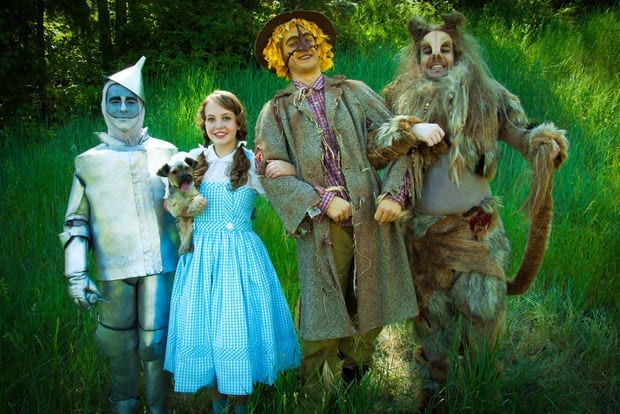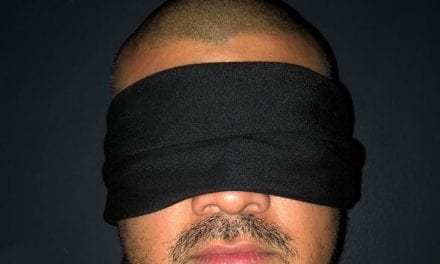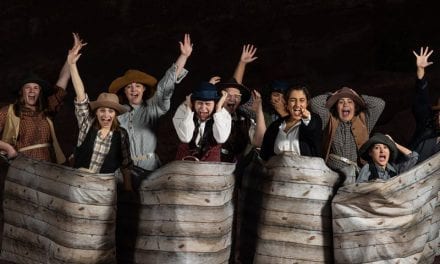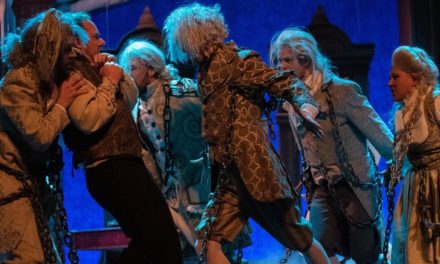SUNDANCE — Theatre in the mountains surrounding Robert Redford’s Sundance resort is always magical. The journey by car up the canyon followed by the climb to the amphitheater (by foot or by tractor pull) takes just enough time to build a sparkling anticipation that makes each show that much better.
In the case of The Wizard of Oz, directed by Laurie Harrop-Purser, that sparkling anticipation was needed, because by itself, the show fell short of my high expectations. It is a fun production with an enthusiastic cast and a story beloved by generations, but it simply doesn’t measure up to Sundance productions I have seen in the past, due in large part to poor visual elements and awkward moments of direction.
It’s always difficult to mount a production of a work like The Wizard of Oz that is so ingrained in popular culture, but it is possible. The Broadway tour of The Wizard of Oz that visited in Salt Lake City a year and a half ago is a good example of a production that was able to capitalize on just enough nostalgia while also adding original elements so as to create a fresh, satisfying production. The Wizard of Oz at Sundance misses the mark in that regard. Despite the fact that there is some effort at familiar visuals from the 1939 movie (for instance, the woman knitting in her rocking chair that Dorothy sees during the tornado makes an appearance), they aren’t presented in such a way that they add significantly to the experience of the production.

Maxwell Higbee as the Tinman, Hannah Pyper as Dorothy, C. McKay Nicoll as the Scarecrow, and Wade Jonson as the Lion. Photo by Jaron Kent Hermansen.
In addition, the inclusion of the “Jitterbug” number that was deleted from the 1939 film detracts from the stage production. Only avid Wizard of Oz fans would be familiar with it, leaving most audience members distracted and puzzled at the awkward performance of the song that was deleted from the film for a very good reason. Also distracting was the inexplicable addition of popular culture references in the production (the trees, for instance, shout “How do you like them apples?” when socking it to Dorothy and the Scarecrow) that seemed out of place.
Given the various challenges directors and producers have when mounting such an iconic production as The Wizard of Oz, it is imperative that production elements are of the highest standard. Unfortunately, this is where Sundance’s production failed most sincerely. The set design by Stephen Purdy was so inferior to professional productions, past Sundance productions, and even college productions that it was positively distracting. The set consisted of a paneled backdrops covered in green plastic floral sheeting, such as would be found draped over parade floats. Attached to this plastic sheeting were scattered pinwheels (such as those found at the Dollar Store), picture frames and plates, and various pieces of scrap wood painted in multi-colors. Some of these pieces of scrap-wood were nailed together to form the skeletons of leafless trees. It was obvious that the design concept meant to convey the mental destruction of the tornado in Dorothy’s head and the subsequent fractured reconstruction of reality into the dreamland of Oz. While this design concept is reasonable, the practical application of the concept was disappointing. Everything, from backdrop to props, seemed cheap and hastily put together. This is in contrast to Sundance productions I have attended in the past, including last year’s Fiddler on the Roof, also designed by Stephen Purdy, where the scene design has been on par with the excellent level of performance.
In contrast to the scenic elements, the costume design by Carla Summers was spectacular. Every one of the characters in Oz was endowed with magic by virtue of what they wore, though the Munchkins stole the show. Dressed in fantastical garb, each Munchkin actor (except one that was already possessed of short legs) walked the stage on their knees with small “legs” sewn onto their thighs so that it appeared as if their legs were extremely and hilariously thin and short for their bodies. The costumes greatly assisted the excellent choreography by Addison Welch in the “Munchkinland” number and made it the absolute highlight of the show.
Detracting from the show, however, were the numerous costume malfunctions that took place opening night. Poor Dorothy was kept busy picking up fallen pieces of puppetry, head gear, and the like that it was hard not to feel sorry for her. Hopefully these are kinks that have since been worked out and won’t be repeated in subsequent performances. I similarly hope that scene changes become more brisk and less awkward, as it seemed that set transitions were slightly more labored than they ought to be, especially given the relatively brisk pace of the rest of the production.
Good acting is often able to compensate for many flaws on stage, and that is the case in the performance I saw. Though Hannah Pyper as Dorothy isn’t able to match the legendary performance by Judy Garland, she holds her own in the role, giving it a more child-like performance that suits the production. So, too, Cleveland McKay Nicoll as Hunk/Scarecrow, Wade Robert Johnson as Zeke/Lion, and Maxwell Higbee as Hickory/Tinman give energetic, spirited performances that humor and delight. Kim Abunuwara’s Wicked Witch of the West is positively perfect as well, nicely channeling the original performance by Margaret Hamilton.
The ensemble was a very good supporting cast, hindered only be moments of what appeared to be awkward direction. Indeed, it seemed that Harrop-Purser’s directing strength is found in scenes with fewer characters, as the larger crowds made for the less dynamic moments in the play. So, too, the twister scene, admittedly a difficult one to stage, was not as nicely directed as I had hoped: the movement was somewhat ill-organized and needed more of a seamless choreography of frenzy. That said, there were a number of magical moments on stage including the Poppy scene and the Scarecrow in the cornfield.
In all, The Wizard of Oz at Sundance may fall short of the experiences I have had at Sundance shows in the past, but it is still worth going to see, adding as it does to the collective experience of L. Frank Baum‘s Oz magic (with its music by Harold Arlen and Herbert Stothart and lyrics by E. Y. Harburg) with its own take on what it means to “Follow the yellow brick road.”






